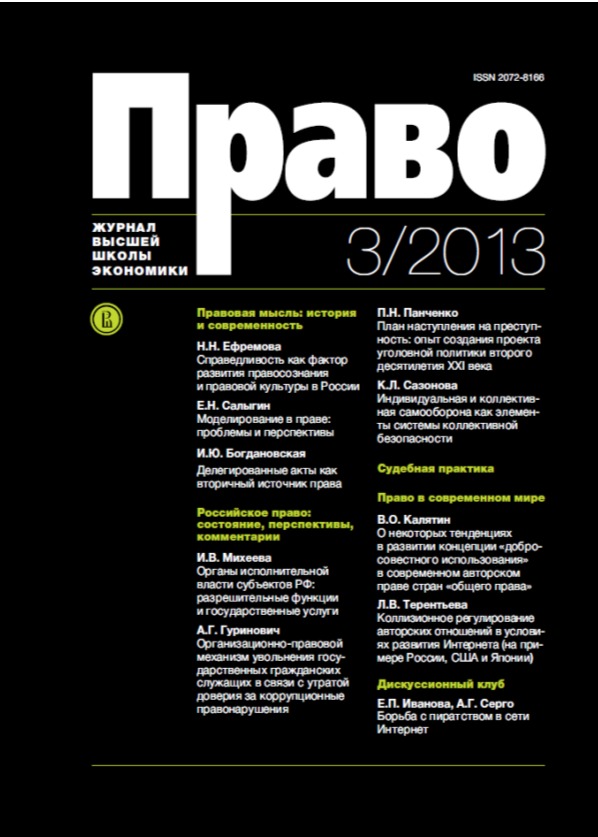Modelling in Law: Challenges and Prospects
Abstract
The article features the use of the method of forecast modeling. It describes the approaches to forecast legal modeling and reveals its signs as well as the major trends in modeling relevant to law. The author notes that in the theory of law, modeling tends to be identified with abstracting and legal models are associated with legal abstractions reflecting common features of phenomena and concepts. Identifying modeling with abstracting and simultaneously making a narrow dogmatic interpretation of law as a system of legal concepts in legal science hinder the development of the legal modeling theory. Legal modeling does not go beyond attempts of creating abstract legal concepts. The article suggests using sociological approach which interprets law as social facts. Only this approach may provide opportunities of studying legal modeling of real legal processes on the basis of empirical information and data. Forecast modeling of normative legal acts may become the most prospective area. The key role in the forecast modeling of legal behavior is seen in the behavioral factor though individual and group legal behavior presuppose the motives and other stimuli including rational choice which has been developed in economic theory. The construction of legal behavior model should be based on systematic approach implying the influence of norms and other social regulators, which is represented with the category institution. In turn, institutions should be considered in a wider prospective as the elements of social structure. This requires a model for the entire modern Russian society, its social and political systems. The limited access society theory described by D. North, J. Wallis and B. Weingast is supposed to be the basis for the model. The article is concluded with the details of the method of legal forecasting, forecasting legal model, and the definitions of the subject and object of the research, and the technology of forecast legal modeling incorporating several stages: 1) preparation stage, 2) problems of modeling, 3) definitions of aims, tasks and the subject of legal modeling, 6) research of the model in simulating regime, verification, 7) data and results of legal modeling.
References
Alexeev S. (2009) Obscshaya teoriya prava: uchebnik, 2 izdanie. [General Theory of Law. A Textbook, 2nd edition], Moscow, Prospect, pp. 120-123.
Arrow K. (2004) Kollektivnyi vybor I individual'niye tsennosti [Social Choice and Individual Values]. Moscow, HSE.
Arshinskiy L., Zhigalov N., Munkozhargalov Ts. (2013) Problemy primineniya informatsionnogo i logiko-matematicheskogo modelirovaniya v sudebnoy ekspertize I kriminalistike [Problems of Using Information and Logic Mathematical Modeling in Judicial Expertise and Criminal Studies]. Rossiskii Sledovatel' — Russian investigator, no 2, pp. 5-9.
Arzamasov Yu., Nakonechniy Ya. (2009) Monitoring v pravotvorchestve: teoriya i metodologiya [Monitoring in Lawmaking: Theory and Methodology]. Moscow, Prospekt.
Avanesov G. (1972) Teoriya i metodologiya kriminologicheskogo prognozirovaniya [Theory and Methodology of Criminal Study Prediction], Moscow, Yuridicheskaya literatura.
Avtonomov V. (1993) Chelovek v zerkale ekonomicheskoy istorii (Ocherk istorii zapadnoy ekonomicheskoy mysli) [Person in the Mirror of Economic History (An Essay on the History of Western Economic Thought)], Moscow: Nauka, pp. 78-80.
Berzin' O. (2011) Kriminalisticheskiye podkhody k modelirovaniyu prestupnoy deyatel'nosti [Criminal Study Approaches to Modeling if Criminal Activity]. Pravo. Zhurnal Vyscshey shkoly ekonomiki — Law. Journal of Higher School of Economics, no. 4, pp. 133-143.
Bezrukov A. (2008) Modelirovaniye v prave [Modelling in Law]. Vestnik Vladimirskogo yuridicheskogo instituta — Bulletin of Vladimir Juridical Institute, no 1, pp. 42-45.
Bezrukov A. (2008) Pravovaya model' kak instrumentyuridicheskoy nauki i praktiki. Avtoref. diss. kand. jurid. nauk [Legal Model as an Instrument of Legal Science and Practice. PhD Thesis]. Vladimir: Vladimir State University, p. 8.
Cherdantsev A. (1999) Teoriya gosudarstva I prava: Uchebnik dlya vuzov [Theory of State and Law: A Textbook for Universities]. Moscow: Yurite, p. 38.
Coleman J. (1990) Foundations of Social Theory. Cambridge, MA; London, England: The Belknap Press of Harvard University Press.
Degtyarev D. (2011) Teoretiko-igrovoi podkhod v prave [Theory and Game Approach in Law]. Moscow, LENAD.
El'ster Yu. (2011) Obyasnenie sotsial'nogo povedeniya: eshchyo raz ob osnovakh sotsial'nykh nauk [Explaining Social Behavior: New in the Fundamentals of Social Sciences]. Moscow, HSE.
Floka A. (2007) Modeli i metody analiza dannykh v pravvokhranitel'noy deyatel'nosti [Models and Methods of Analyzing Data in Law Enforcement Activity]. Moscow, 224 p.
Frolov I. (1961) Gnoseologicheskie problemy modelirovaniya biologicheskikh system [Gnoseological Problems of Modelling Biological Systems]. Voprosy filosofii — Questions of philosophy, no 2, pp. 26-30.
Gavrilov O. (1980) Matematicheskie metody v juridicheskoy nauke. Metodologicheskie problemy sovetskoy juridicheskoy nauki [Mathematical Methods in Legal Science. Methodological Issues of Soviet Legal Science]. Moscow, Nauka.
Gavrilov O. (1980) Matematicheskie metody I modely v sotsial'no-pravovom issledovanii [Mathematical Methods and Models in Social and Legal Research]. Moscow, Nauka.
Goroshko I., Sichkaruk V., Floka B. (2007) Modeli i metody analiza dannykh v pravookhranitel'noy deyatel'nosti [Models and Methods of Data Analysis in Law Enforcement Activity]. Moscow: Prospekt, p. 29.
Granovskiy G. (1969) Novye priemy i sredstva modelirovaniya v trasologii [New Tools and Devices of Modeling in Trasologiya]. Kriminalistika i sudebnaya expertiza — Criminal studies andjudicial examination, no 6, pp. 240-248.
Gudkov L. (2011) Abortivnaya modernizatsiya [Abortive Modernization]. Moscow, Rossiyskaya politicheskaya entsiklopediya (ROSSPEN), 328 p.
Gustov G. (1980) Modelirovanie v rabote sledovatelya [Modelling in the Work of Investigator]. Leningrad, Leningrad State University.
Kazimirchuk V. (1967) Sotsiologitcheskie issledovaniya v prave: problemy i perspektivy [Sociological Research in Law: Problems and Outlook]. Sovetskoe gosudarstvo i pravo — Soviet state and law, no 10, pp. 232-250.
Kononenko V., Minaev V. (1981) Dinamicheskie modeli prestupnosti. Metody issledovaniya slozhnykh system [Dynamic Models of Criminality. Methods of Researching Complicated Systems]. Moscow, VNIISI.
Koshmanov M., Lyapichev V. (1990) Metody matematicheskogo modelirovaniya v pocherkovedcheskoy ekspertize [Methods of Mathematical Modeling in Graphologic Examination]. Moscow, Moscow State University.
Kudryavtsev V. (1968) Prichinnost' v kriminologii (struktura individual'nogo prestupnogo povedeniya) [Causality in Criminal Studies (Structure of Individual Criminal Behavior)]. Moscow, Gosyurizdat.
Kudryavtsev V. (1998) Genezis prestupleniya. Opyt kriminologicheskogo modelirovaniya: Uchebnoe posobie [Genesis of Crime. Case Study of Criminal Modeling: A Manual]. Moscow: Izdatel'skaya gruppa “Forum-INFRA-M”, 1998, 215 p.
Kuran T., Sunstein C. (1999) Availability cascades and risk regulation Stanford Law Rev. 51: 683-768. DOI: https://doi.org/10.2307/1229439
Lazarev V., Lipen' S. (2000) Teoriya gosudarstva i prava: Uchebnik dlya vuzov. 2 izd. ispr i dop. [Theory of State and Law: A Textbook for Universities 2nd Edition Revised]. Moscow, Spark, p. 16.
Levada Yu. (2006) Ischem tcheloveka: Sotsiologicheskie ocherki, 2000-2005 [In Search of a Person. Sociological Essays, 2000-2005]. Moscow, Novoe izdatel'stvo, 276 p.
Levanskii V. (1986) Modelirovanie v sotsial'no-pravovykh issledovaniyakh [Modelling in Social and Legal Research]. Moscow: Nauka, p. 89.
Lubin A., Gubanischev V. (2009) Obschaya model' mekhanisma prestupnoi deyatel'nosti v sfere ekonomiki: usloviya formirovaniya [General Model of the Mechanism of Criminal Activity in Economy]. Ekonomicheskaya bezopasnost' Rossii — Economic security of Russia, no 1, pp. 82-88.
Luzgin I. (1981) Modelirovanie pri rassledovanii prestuplenii [Modelling in Investigating Crimes]. Moscow, Nauka.
Marschak J. (1971) Economics of Information Systems, Amsterdam, North-Holland. DOI: https://doi.org/10.2307/2284873
Morgan M., Morrison M. (Eds.) (2000) Models as mediators: Perspectives on the natural and social sciences. Cambridge, Cambridge University Press.
Novik I. (1965) O modelirovanii slozhnykh sistem (filosofskii ocherk) [On Modeling Complex Systems (a Philosophical Essay)]. Moscow, Mysl'.
North D. (2010) Ponimanie processa ekonomicheskikh izmenenii [Understanding the Process of Economic Change]. Moscow, HSE, p. 79.
North D., Wallis J., Weingast B. (2011) Nasiliye i sotsial'niye poryadki. Kontseptual'niye poryadki dlya interpretatsii pis'mennoy istorii chelovechestva [Violence and Social Orders: A Conceptual Framework for Interpreting Recorded Human History]. Moscow, Izd. Instituta Gaidara.
Pincock C. (2007) [forthcoming] Modeling reality. Synthese. 180:19-32. DOI: https://doi.org/10.1007/s11229-009-9564-2
Polishchyuk L. (2008) Netselevoe ispol'zovanie institutov: prichiny i sledstviya [Improper Use of Institutes: Causes and Effects]. Voprosiy ekonomiki — Questions of econom ics, no 8.
Robbins L. (1993) Predmet ekonomicheskoy nauki. Thesis: teoriya I istoriya ekonomicheskikh i sotsial'nykh institutov i system. Predmet issledovaniya [Subject-matter of Economic Science. Thesis: Theory and History of Economic and Social Institutions and Systems. Subject-matter of Research]. Moscow: Nachala-press, vol. 1, issue 1.
Rudashevskiy E. (1980) Pravo i modelirovanie. Metodologicheskie problenmy sovetskoy juridicheskoy nauki [Law and Modeling. Methodological Problems of Soviet Legal Science]. Moscow, Nauka, p. 37.
Salygin E. (2012) Modelirovanie pravovogo povedeniya: ekonomicheskii aspect. Pravovye issledovaniya: novye podkhody. Sbornik statey fakul'teta prava NIU VShE [Modelling Legal Behavior: Economic Aspect/Legal Research: New Approaches. Proceedings of HSE Law Faculty]. Moscow, HSE, pp. 9-28.
Satarov G. (2011) Formal'nye i neformal'nye aspekty v protsesse transformatsii sudebnoy vlasti. Pravo i pravoprimenenie v Rossii: mezhdistciplinarnye issledovaniya [Formal and Informal Aspects in the Process of Transforming Judicial Power. Law and Use of Law in Russia: Interdisciplinary Research]. Moscow, Statut, pp. 145-148.
Shastitko A. (2011) Modeli cheloveka v ekonomicheskoi teorii: Uchebnoe posobie [Models of a Person in Economic Theory: A Manual]. Moscow, INFRA-M.
Shcherbakov V. (2012) O kriminologicheskom modelirovanii effectivnogo preduprezhdeniya prestupnosti v sovremennykh usloviyakh [On Criminal Study Modeling of Efficient Protection From Crimes in Modern Circumstances]. Vestnik Moskovskogo universiteta MVD Rossii — Bulletin of Moscow University of Russian Internal Ministry, no 10.
Schermerhorn J., Hunt J., Osborn R. (2004) Organizatsionnoe povedenie [Organizational Behavior]. Saint Petersburg, Piter.
Slovic P. (2007) The Perception of Risk. Earthscan Publications Ltd., London UK and Sterling, VA, USA.
Suarez M., Cartwright N. (2008) Theories: Tools versus Models. Studies in the History and Philosophy of Modern Physics. no 39. DOI: https://doi.org/10.1016/j.shpsb.2007.05.004
Sunstein C. (2000) The Laws offear. Harvard Law Rev. 115:1119-68. DOI: https://doi.org/10.2307/1342630
Varchuk T. (2012) Viktimologicheskoe modelirovanie v teorii determinatsii prestupnosti [Victimological Modelling in the Theory of Determining Criminality], Vestnik Moskovskogo universiteta MVD Rossii — Bulletin of Moscow University of Russian Internal Ministry, no 10.
Vitsyn S. (1973) Modelirovanie v kriminologii. Uchebnoe posobie [Modelling in Criminal Studies. A Manual], Moscow, NIiRIO VSh MVD SSSR.
Winter G. (1993) The Nature of the Firm. New York: Oxford University Press.
Copyright (c) 2013 Law Journal of the Higher School of Economics

This work is licensed under a Creative Commons Attribution-ShareAlike 4.0 International License.


















